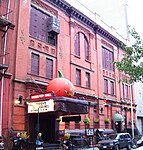Classic Stage Company
1967 establishments in New York CityArts organizations established in 1967East Village, ManhattanObie Award recipientsOff-Broadway theaters ... and 2 more
Theatre companies in New York CityUnion Square, Manhattan

Classic Stage Company, or CSC, is a classical Off-Broadway theater. Founded in 1967, Classic Stage Company is one of Off-Broadway's oldest theaters. Its 199-seat theatre is the former Abbey Theatre located at 136 East 13th Street between Third and Fourth Avenues in the East Village near Union Square, Manhattan, New York City. Classic Stage Company is led by Artistic Director John Doyle. Its productions have been cited repeatedly by the major Off-Broadway theater awards: Obie Award, Drama Desk Award, Outer Critics Circle Award, Drama League Award and 1999 Lucille Lortel Award for Outstanding Body of Work.
Excerpt from the Wikipedia article Classic Stage Company (License: CC BY-SA 3.0, Authors, Images).Classic Stage Company
East 13th Street, New York Manhattan
Geographical coordinates (GPS) Address Nearby Places Show on map
Geographical coordinates (GPS)
| Latitude | Longitude |
|---|---|
| N 40.732781 ° | E -73.988309 ° |
Address
Everyman Espresso
East 13th Street 134
10003 New York, Manhattan
New York, United States
Open on Google Maps










